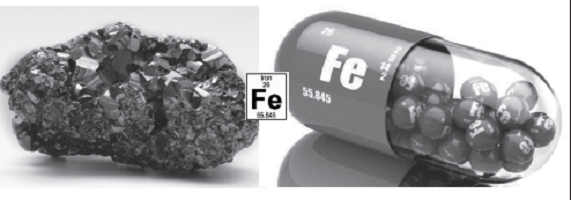From playing the role of a vital building block of steel to helping produce chlorophyll in plants and in carrying oxygen in the blood of humans and animals, iron is a hardworking element, busy helping sustain life on Earth in myriad ways.
A brittle, hard substance, with a shiny, silvery grey appearance, iron is classified as a transitional metal in Group 8 of the Periodic Table. It is the most abundant of all metals, the cheapest metal, and also the metal that is used the most in the world. Around 90% of all the metal that is refined today is iron, most of it being used to produce steel, an important and versatile alloy of iron and carbon. The pure metal is chemically highly reactive and corrodes rapidly on being exposed to moisture and high temperatures. It is present in the combined form in most igneous rocks. The most common ore of iron is haematite, its other widely distributed minerals being magnetite and taconite.
A major part of the Earth’s solid and liquid cores is thought to be made up of iron. The electric current produced by the liquid iron in the Earth’s core creates the magnetic field protecting the planet. In addition to being found abundantly on Earth, Iron is also found in large quantities in the sun, the stars, and in the cores of all of the planets in our Solar System. The large amount of iron oxide on the surface of Mars gives this planet its red colour.
A long and interesting history
According to archeologists, people have been using iron for more than five millennia. Almost all of the iron used in ancient times came from meteors that fell to Earth from the sky. This has been proved from the composition of ancient iron artifacts that have been found to contain around 7.5% nickel, matching the typical composition of meteorites known as siderites. Such old iron artifacts, many of which have been found in Egyptian tombs dating back to around 3500 BC, could resist getting rusted on account of their nickel content.
As for iron smelting, its history can be traced back to around 1500 BC when the ancient Hittites of Asia Minor (Turkey) seemed to have discovered how iron could be smelted from its ores. But they managed to keep this process a secret for a long time, because this new metal, from which they prepared various weapons of war, gave them their economic and political power. The discovery of iron smelting led to the widespread use of iron and the commencement of a period in world history called the Iron Age.
In 585 BC, the Greek philosopher Thales reported that pieces of a type of iron ore had the power to attract iron filings. These pieces of the ore were called magnets after the place from which they came to a place called Magnesia in Asia Minor. They were also called lodestones, and the iron ore is called magnetite. Ancient Greek potters were known to have used iron as a pigment. They had discovered that items of iron, when fired under oxidising conditions, would be red in colour (because of the formation of Fe2O3), whereas those fired under reducing conditions would be black (due to the Fe3O4 that was formed).
The 7-meter high iron pillar of Delhi dates back to around 400 AD and is famous for being rust-resistant. The secret behind its ability to stay uncorroded for over a millennium is believed to be the unique composition of the iron from which it was made.
Iron is commercially produced in a blast furnace by heating haematite or magnetite with coke and limestone at temperatures of around 2000o C. The pig iron obtained from this process contains around 3% carbon and other impurities, and is used for producing steel. Each year, around 1.3 billion tonnes of crude steel is produced worldwide.
Properties and uses
Like the other transition metals, iron is ductile, malleable, and a good conductor of heat and electricity. Iron has the most applications of all metals even today, its use ranging from the manufacture of tiny paper staples to building huge ships. The reason for its multitudinous uses is its alluring combination of low cost and high strength.
Around the time of the Industrial Revolution in the 18th century, when coke rather than charcoal began to be used for smelting iron, it resulted in cheap wrought iron becoming available for use in transport and architecture. The first all-iron bridge was built in England, in 1778, and then the nearby town was named Ironbridge after this historic bridge that is still standing today as a striking symbol of the dawn of the Industrial Revolution. The biggest benefit of large-scale production of iron was experienced by the transport industry with the invention of locomotives or Iron Horses (that’s what the first trains were called) followed by the development of the railways from around the 1830s.
Like the metal itself, alloys of iron too have numerous uses. The best-known alloy of iron is steel. Ordinary carbon steel is an alloy of iron containing a small amount carbon ranging from 0.1% for mild steel up to 2% for high carbon steels. Alloy steels are produced by mixing carbon steels with other additives such as nickel, chromium, vanadium, tungsten and manganese. These are even stronger and tougher than carbon steels and are used for bridges, and in the manufacture of products like electricity pylons, bicycle chains, and cutting tools. Stainless steel contains at least 10.5% chromium. It is highly corrosion-resistant and used for making cutlery and cooking utensils.
Iron’s amazing magnetic properties make it useful for devices like electric motors, generators, and transformers, to mention a few. In the 1830s, Joseph Henry developed the first powerful electromagnet in the world. Nowadays, iron is alloyed with rare earth elements like neodymium to produce very powerful small magnets.
The Haber process for producing ammonia, and the Fischer–Tropsch process for converting syngas into liquid fuels make use of iron catalysts.
Iron’s biological role
Iron is essential for all forms of life. Most of the iron in our bodies is in the haemoglobin in our blood. Iron is an important nutrient for humans who need to have around 10-18 mg of it in their diet every day. A lack of iron causes anaemia and fatigue and a reduced capacity for physical work and is also linked with depression and impaired memory in teenagers. Iron sulphate is used for treating iron deficiency. On the other hand, increased iron levels in the body could lead to cardiovascular problems, and an accumulation of iron in the brain could increase the risk of developing Alzheimer’s disease.
Future uses
In recent times, researchers are working on the development of inexpensive and environment-friendly solar cells through the use of iron-based dyes. Iron, being much cheaper than the more expensive and rare metals used currently, will lower the cost of producing solar cells and light catchers.
Scientists are also researching the use of polymer-coated iron oxide nanoparticles for breaking up clusters of bacteria, and facilitating more effective treatment of chronic bacterial infections, particularly hard to treat hospital infections.
In today’s computer and internet age, we often tend to get overwhelmed by the benefits we enjoy due to advances in consumer electronics products. But if we stop to think about it, we would realise that surviving without microchips and modern gadgets would still be possible. In contrast, though we hardly pay any attention to this plain truth, we depend so much on steel in our day to day lives that it would be impossible to live without it. And as long as man’s aspirations continue to expand and diversify, the need and the demand for steel in construction, transport, and for countless other uses will only continue to grow.
References
- Royal Society of Chemistry: Iron -http://www.rsc.org/periodic-table/element/26/iron
- Agata Blaszczak-Boxe: Facts about iron – 22 August 2017, https://www.livescience.com/29263-iron.html
- World of Molecules: Iron – https://www.worldofmolecules.com/elements/iron.htm
- John Elmsley: Iron – Nature’s Building Blocks: An A-Z Guide to the Elements, p 205-211, 2001
- Radio Chemistry Society: Iron – https://www.radiochemistry.org/periodictable/elements/26.html
- Petter Persson: Solar cells of the future could be based on iron molecules – Phys.org, 18 May, 2016, https://phys.org/news/2016-05-solar-cells-future-based-iron.html
- University of New South Wales: Nanotech weapon against chronic bacterial infections – 21 Dec, 2015, http://www.understandingnano.com/iron-oxide-nanoparticles-bacteria.html
- Los Alamos National laboratory: Iron – https://periodic.lanl.gov/26.shtml

































